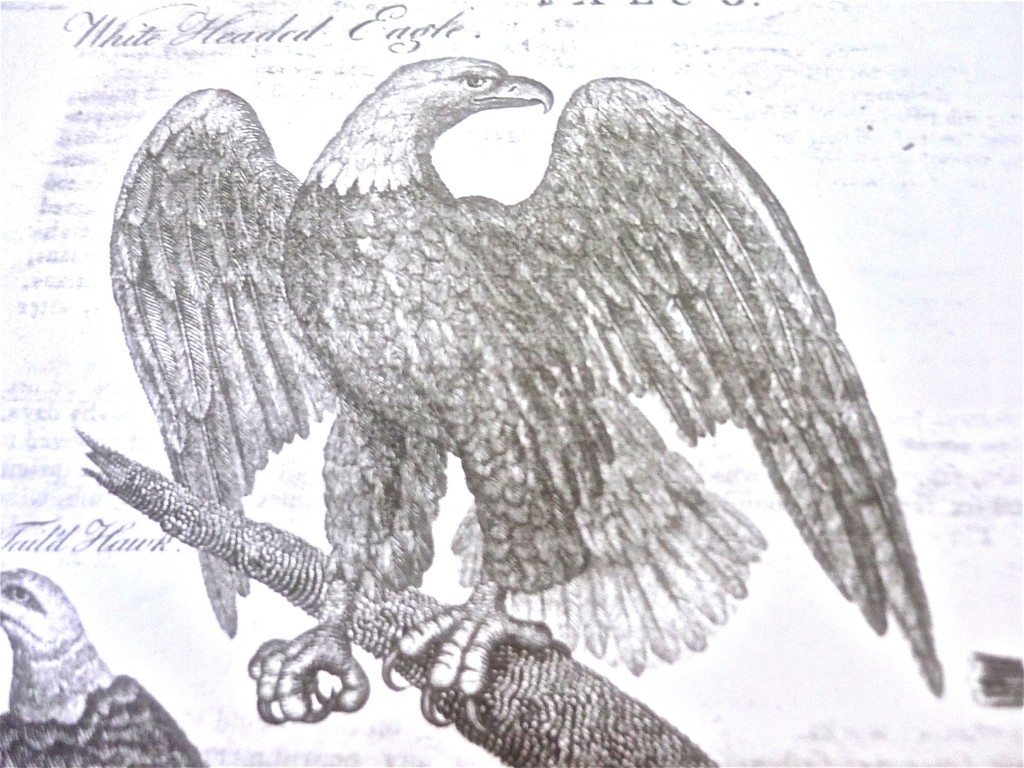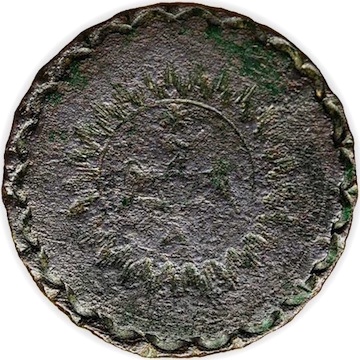
When the Jacobites Restore Their Ruling Families Power
Through Washington’s Administration
*
GWI 14 A, B, & C The Federal Eagle Under a Saint Andrew’s Cross: GWI 14’s pattern depicts a Rising Federal Eagle in the center of a Sunburst pattern. Above the eagle’s head is the Cross of St. Andrews the patron Saint of Scotland. In GWI 14-A there is a Single Arrow going through the center of the St. Andrew’s cross pointing downward at the rising federal eagle. This provides a symbol of religious significance relating to divine authority and sovereignty. GWI 14-B & C depicts a different symbol of a Six-Point Estoile Star. This represents a Judaeo-Christian heraldry (blessing) over America’s federal government. This estoile symbol would be recognized as divine authority for George Washington’s right to rule. Surrounding the federal eagle is a Sunburst pattern reaching outward into the celestial heavens as all other nations have done throughout the history of the world. This would have relations to GWI 14-A Crescent Moon legend design. This design represents the Celtic (Scotland, Ireland, Norway (Isle of Man), Welsh, Brittany, and Cornwall) Moon symbolism of 3. The word “crescent” comes from the Latin term ceres which means to bring forth or create new, and crescere is the Latin term for “grow and thrive.” The Crescent Moons adds onto the religious St. Andrew’s Scottish allusion by incorporating the Regnal Jewels of Scotland. This was artistically done by adjoining the bases of two 3 sided triangles crimped down in-between each crescent moon. So, GWI 14’s design taken in whole is a Scottish Royal Culture religious sovereignty pattern for America by the use of their celestial stars & crescent moon symbols which comes from their (1) practicing arts,(2) religion, and (3) art.
GWI 14-B has a Reeded Edge legend. This is the only George Washington inaugural button to have this reeding technique (GWI 30 has a Beaded Edge). GWI 14-B should be seen as the earliest American example using this design which pre-dates it’s technique applied to the first U.S. Mint coins of 1792/3. Even though there is a similar raised legend pattern (not incuse) from New Jersey and Vermont this would not be parallel to the use of reeded edges for anti-currency techniques to prevent shaving coins for silver or gold. The fact is Robert Scot came to the US from Scotland as a currency counterfeit expert, and was George Washington’s appointment as the 1st Chief engraver of the new United States Mint. GWI 14-B could have been a new technique he devised prior to his implementation on the First U.S Coins. Since Gold and Silver Coins went by weight, this technique could stop people from shaving off the sided and keeping the issue’s weight it’s correct monetary value. Meaning, once again that GWI 14-B could very well be ( A F** Prize to Coin Collectors) the earliest representation of the anti-counterfeit mechanics to be used in the 1st U.S. Gold and Silver Dollars.
GWI 14-C legend depicts the shape of the Regnal Jewels of Scotland. There appears to be 29 jewels circling around the outside perimeter. This Scottish theme would be in-line with the Scottish artisan’s motif’s, but unfortunately I have not have had the privilege of examining this button in-hand, and the only one specimen that is known is by an old photo.
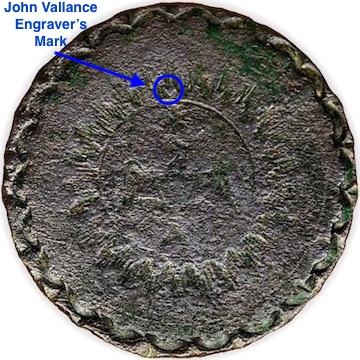
NNT’s Engraver’s Mark “V” for John Vallance
GWI 14-A & B was engraved by Robert Scot and John Vallance for George Washington’s inaugural celebration. GWI 14 was engraved in a steel die hub, and then stamped into either brass or copper planchets. Most probably all three variants of the buttons had either a gilt or silver-wash finish. The Size for GWI 14-A & C is 34mm, and NNT 14-B is a bit smaller at 32mm. All three GWI 14 variations have an R-7 Rarity Rating because each of the surviving specimens has a unique legend pattern. As of 2018, there is a total of five known specimens, and each button has one of three legend designs. I was able to re-introduce two legend designs because of contemporary metal detector finds. Without an in-hand examination, I have not been able to authenticate GWI 14-C as authentic to the 1789-97 celebratory time frame, but I was able to obtain a picture before 2004. Meaning, this pattern could be attributed to an early anniversary issue over a modern day forgery. So, in total GWI 14-A has three known surviving specimens, and GWI 14 B & C each have one known specimen.
Robert’s Notes
The Scottish Meaning Behind GWI 14’s Design
GWI 14 should be viewed as the control over the federal government by Scottish-American high society families who wanted to start a New Republic. The pattern’s multi-layered allusion symbols declares there was a Scottish Representative influence within the Continental Congress. This is backed-up by factual information by Congressional Presidents like Arthur Saint Clair, and other Congressional committee members who pushed for the Bonnie to reign before his death in 1788. After the war’s end in 1784, the Scottish high society families were seraticiously infusing Scottish Royal Culture and Judaeo-Christian heraldry into America’s fabric through Robert Scot and his Philadelphia artisans. This infusion of art was simultaneously working in conjunction with political venues to propagate loyal Scottish families to the House of Stuart into powerful positions in and out of government. During the revolution and afterwards these Scottish families who held the real wealth and power worked through George Washington because he had control and leadership over the battlefield patriots and ordinary citizens. With the untimely death of Prince Edward Stuart in 1788, George Washington was obligated to take on the role as President in 1789.
The rising Eagle (Phoenix) in the center of the sunburst should be viewed as the “Re-birth of the Scottish High Society who are loyalists to the House of Stuart. These people were ousted out of their political and economic positions of power in Europe by the English Hanoverian royal family in 1698. If Prince Edward Stuart’s did not die in 1788, the button’s design would have been seen as the Stuart houses rebirth of control over Scotland, England, and Ireland. The “Rising” part would have been his expanded divine authority to include America. Since the Bonnie Prince did die in 1788, the Jacobite high society families used the symbol to represent their control within the federal government. This action is also supported through many of our country’s establishing official empowering authority government functioning items such as, insignias, official seals, militia flags, paper money; and many other non-official in-conjuntion items like GWI & NNT buttons. More important collaborating evidence is found by in the recorded actions of the individual committee chairmans who had direct influence within the Continental Congress committee’s final decisions. Early Congressional Presidents like Arthur Saint Clair and other state representatives and Congressional committee members were acting as agents for the wealthy Scottish high society families. Robert Scot’s artisans (James Trenchard, James Thackera, Francis shallus, Samuel Allardice, John Vallance, Joseph write, and Pierre du Simitiere) infused Scottish Royal Culture into America’s fabric by disguising it in the works of people of Charles Thomson and William Barton. This artistry allusion was simultaneously working as a foundation for future Scottish family political and economic authoritative power. A PRIME EXAMPLE would be how the Federal Eagle has a multi-layered allusion which is reinvented from Sir John Scott’s Templar Zoroastrian fire pillar symbolism. This Scottish artistry incorporated within America’s new republic symbols would give a bloodline directly to Scotland’s Sir John and his wife Ann Drummond for heraldry. This 1st century Templar Fire Pillar symbol was honored highly by all the Scottish blue blood families. Hence, Robert Scot would have been the only person to be able to direct, create, and infuse these Scottish Authoritative concepts into the New Republic’s Re-birth insignia symbols.


NNT 14 -A FEDERAL EAGLE WITH ARROW THROUGH ST. ANDREW’S CROSS & COLONIAL BORDER
Color: A Steel Grey with Dark Green & White Encrustation.
Metal: Flat, 1-Piece, Stamped Design, Brass.
Size: 31.86mm. 74.3 Grains.
Rarity: R-7 (1 of 2 Known Specimens).
Variety Type: GWI 14-A.
Present Condition: An Excavated Specimen, Good Planchet Condition, Good Impressions Remain.
Obverse Button Analysis: This ultra rare button still has a nice balance of color and design impressions. The brass planchet is thicker then most GW buttons and is heavy in weight. Unfortunately, this is the Best specimen known to exist for GWI 14-A. The button has an almost granular texture to the touch, and shows both corrosive and micro porous properties throughout the surface. Fortunately, the obverse shows no scratches or rough abrasions from excavation or ground action. The federal style eagle only has a light foot print impression, but still retains a good enough outline and image for viewing. Unfortunately, the Liberty Shield only shows a perimeter outline with no clear inner line detail. The St. Andrew’s Cross & Arrow is mostly decayed into the surface, but does shows a remnant image of it’s former impression. The thinly stamped incuse ring surrounding the Eagle still has a good solid impression except for the lower left 5 o’clock position. The Sunburst’s Flairs still show a good image, and most individual lines easy to see. Of course there are several spots (between the 1:00 and 3:00) where the lines only retains a remnant image. The Border’s outside stipple ring is mostly deteriorated and worn flat into the surface. There are some lasting remnant stipples which can be viewed from the 3:00 to 8:00 o’clock position. The Colonial-Style Crescent Moon design that goes around the border still has a good deep impression and is easily recognized. Unfortunately, most of the Triangle Notches that are in-between the Crescent Moons have decayed and is very hard to see without magnification. There still is a handful that show good form: at 11:00, 2:00, and 3:00 o’clock positions. This button is actually an extraordinary find! Unlike other GW Buttons, this variety probably was only made in a limited quantity. A serious collector should obtain any specimen he can get if one comes available.
Reverse Button Analysis: This is a flat one-piece button with a soldered on loop shank. The shank is original, straight, and intact. The reverse shows a coarse porous surface with corrosion, and green verdigris spots and white encrustations.
Library Records Has Limited Information NNT 14 A-1:
History: Yes Recorded Sales Price: Yes
Current Button Owner and Location: ~ New York ~
The RJ. Silverstein’s Isabela Collection.
This was Dug at an Old Home Site in Rhode Island.~
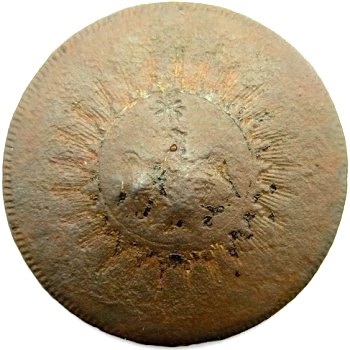

NNT 14 -B A FEDERAL EAGLE WITH ARROW THROUGH ST. ANDREW’S CROSS & REEDED BORDER
Color: A Rusty Orangish Hue With Brown Overtones.
Metal: Flat, 1-Piece, Stamped Design, Gilt Brass.
Size: 31.63mm.
Rarity: R-7 ( Only Known Specimen to Exist ).
Variety Type: 14-B, 32mm.
Present Condition: An Excavated Specimen, Fair Planchet Condition, A Good Impression Remains.
Obverse Button Analysis: This would be the only recorded GW or NNT specimen to demonstrate a reeded design around the periphery. GWI 30 Portrait of Washington has something very similar called a “Beaded Edge.” Robert Scot who was the Master Artisan for the Guilds did use this reeded technique in 1791, when he became Chief Engraver of the United States Mint. Reeding is not an anti-counterfeit technique. It was introduced on Gold and Silver coins to prevent people from shaving off the weight of coins. This technique could guarantee the coin weighed it’s reflective denomination. Obviously, Robert Scot who was brought to America as an anti-counterfeit expert had all the right ties: Politically with Washington / Socially as a Master Mason with Masonic Lodges / Economically by heading the various state guilds. Could this be the First Known Example of the technique before it’s customary use on United States Coins?
Reverse Button Analysis: This is a flat one-piece button with a soldered on loop shank. The shank is original, and intact, but crushed inward from pressure. The reverse shows a porous surface with corrosion.
Library Records Has Limited Information NNT 14 B-1:
History: Yes Recorded Sales Price: Yes
Current Button Owner and Location: ~ New York ~
The RJ. Silverstein’s Isabela Collection.~
*This button was excavated by my friend Tim Myers of Empire State Metal Detecting Club.
He dug this around an old 18th Century stone home foundation site in Petersburg, New York. The button was found 4″ under an old plastic oil container.
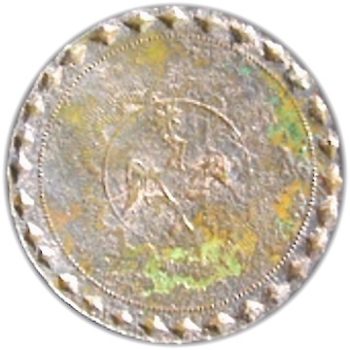
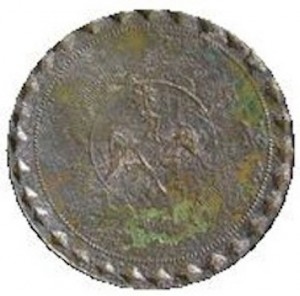
NNT 14 -C A FEDERAL EAGLE WITH ARROW THROUGH ST. ANDREW’S CROSS & DIAMOND BORDER
The Regnal Crown Jewels of Scotland with inner Crosses
Color: A Steel Gray With Green & Orange Encrustations.
Metal: Flat, 1-Piece, Stamped Design, Brass.
Size: 34mm?
Rarity: R-7 ( Unauthenticated Dated Specimen ).
Variety Type: 14-C, Inverted Diamond Border.
Present Condition: An Excavated Specimen, Good Planchet Condition, A Good Impression Remains.
Obverse Button Analysis: I cannot confirm that this specimen is of 1789-1793 period or made in 1801 for the 25th Anniversary of the American Revolution. The paranoid person that sent me this picture could not answer any questions of it’s origins and whereabouts. To this day, he still won’t even give his real name which throws up Many Red Flags in todays collectable field. The GWI 14-A design could have been altered to make it a special use button by Freemasons in a Scottish Masonic Lodge. The button would be needed for examination of maker marks and Scottish symbols.
Reverse Button Analysis: This is a flat one-piece button with a soldered on loop shank.
Library Records Has Limited Information NNT 14 C-1:
History: No Recorded Sales Price: No
Current Button Owner and Location: Unknown Location
This picture is courteous of a “Paranoid Collector” who would not tell his name because he lives in public fear.
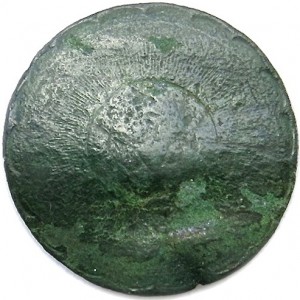

NNT 14 -A FEDERAL EAGLE WITH ARROW THROUGH ST. ANDREW’S CROSS & COLONIAL STYLE BORDER
Color: A Two-Tone Sea-Foam Green.
Metal: Flat, 1-Piece, Stamped Design, Brass.
Size: 31.92mm.
Rarity: R-7 (2 of 2 Known)
Variety Type: 14-A, 34mm.
Present Condition: An Excavated Specimen, Good Planchet Condition, A Fair Impression Remains.
Obverse Button Analysis: This rare specimen of GWI 14-A is in rough shape, but still shows a semi-clear image of it’s original design. The brass planchet does show metal fatigue by being bent and wavy. The button is coarse, porous, pitted, and has a corrosive features on the surface. Luckily, the Federal Eagle still retains a viewable image, but all the inner detail of the head, body, and feathers is lost to ground action or a weak fabrication stamp. There is a thin outline of the Liberty Shield, but unfortunately no inner detail remains. The Olive Branch and Bundle of Arrows is decayed or worn flat into the surface from deteriorating circumstances. The St. Andrews Cross and Arrow has a semi viewable image, but is mostly undefined lines from environmental pitting. The Sun’s incuse ring still shows a deep impression most of the way around. It being weaker of the lower half below the 9 & 3. The Sunburst and emanating lines also shows a stronger image on the upper half then the lower half. As with the inner Sun design, the outer Stippled Ring only shows a partial image of the upper half. The Crescent Moon Border design is is also stronger on the top then the bottom. Most of the Triangle Notches in-between the Crescent Moons are semi-flat.
Reverse Button Analysis: This is a flat one-piece button with a soldered on loop shank. The shank is unfortunately missing.
Library Records Has Limited Information NNT14 A-2:
History: Yes Recorded Sales Price: Yes
Current Button Owner and Location: ~ New York ~
The RJ Silverstein’s Isabela Collection.
*This button was excavated in Curituck County, North Carolina May 18, 2008.~
Figure A.1: Robert Scot’s Illustration of White Headed Eagle in 1792
